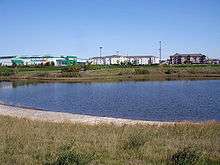
Retention basin
A retention basin is used to manage stormwater runoff to prevent flooding and downstream erosion, and improve water quality in an adjacent river, stream, lake or bay. Sometimes called a wet pond or wet detention basin, it is an artificial lake with vegetation around the perimeter, and includes a permanent pool of water in its design.
It is distinguished from a detention basin, sometimes called a "dry pond," which temporarily stores water after a storm, but eventually empties out at a controlled rate to a downstream water body. It also differs from an infiltration basin which is designed to direct stormwater to groundwater through permeable soils.
Wet ponds are frequently used for water quality improvement, groundwater recharge, flood protection, aesthetic improvement or any combination of these. Sometimes they act as a replacement for the natural absorption of a forest or other natural process that was lost when an area is developed. As such, these structures are designed to blend into neighborhoods and viewed as an amenity.
Podcasts:
Latest News for: retention basin
Bendix earns Ohio EPA’s Encouraging Environmental Excellence Gold Award
The Morning Journal 25 Mar 2025Urgent need for infrastructure upgrades in KZN following flood tragedy
Independent online (SA) 23 Mar 2025Syracuse firefighters battle large brush fire in Skunk City not far from homes, zoo
The Post-Standard 20 Mar 2025Oakland Co. water chief fires back at Macomb Co.: Basin water is 'crystal clear'
Detroit news 17 Mar 2025Oakland County water officials says basin’s discharges are ‘crystal clear’
Macomb Daily 17 Mar 2025Opinion: Oakland County needs to stop flushing their problems our way
Macomb Daily 14 Mar 2025Expert tips for Atlanta property owners on how to detect and address stormwater issues before ...
Business Journal 10 Mar 2025- 1

